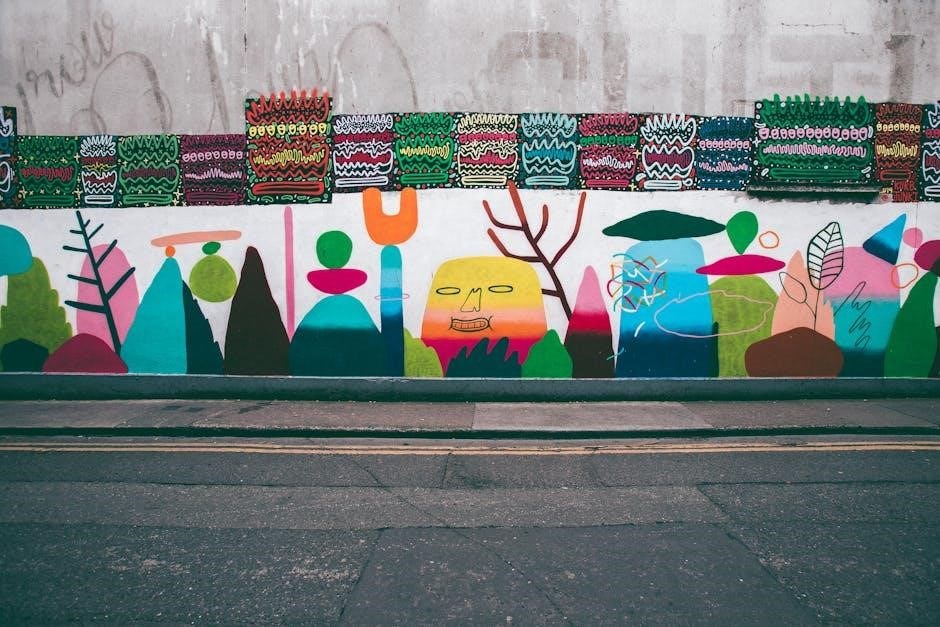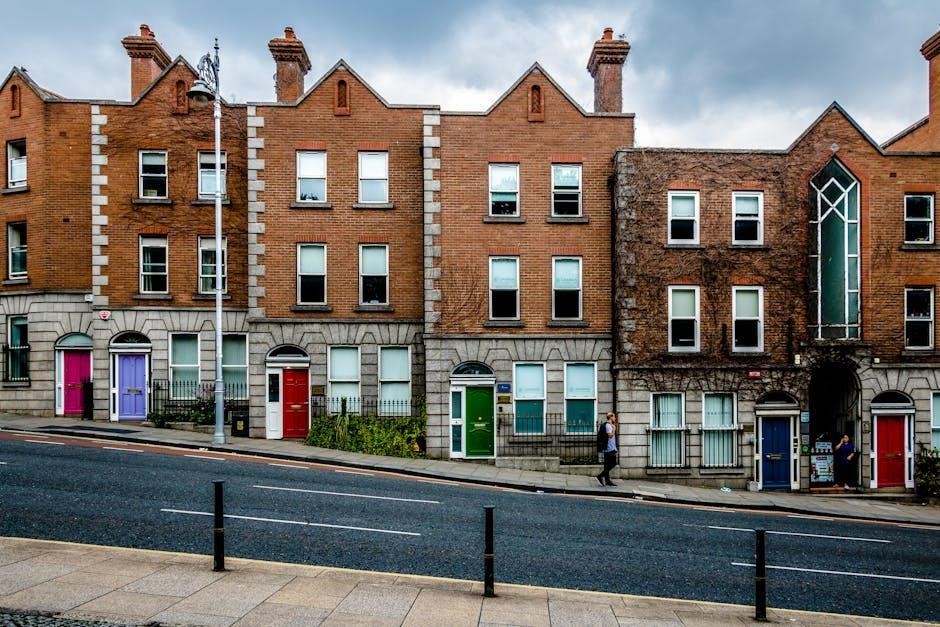dubliners james joyce pdf

James Joyce’s Dubliners is a collection of 15 short stories portraying early 20th-century Dublin, exploring themes of paralysis and stagnation in Irish society.
1.1 Overview of the Collection
Dubliners, James Joyce’s debut collection, contains 15 short stories that vividly capture life in early 20th-century Dublin. Each tale explores the city’s social fabric, revealing the struggles and monotony of its inhabitants. The stories are linked by themes of paralysis and stagnation, reflecting Joyce’s critical view of Irish society. From the death of a priest in “The Sisters” to the romantic disillusionment in “Araby,” the collection offers a profound yet intimate portrayal of Dublin’s everyday life, showcasing Joyce’s mastery of realistic storytelling and his deep connection to his native city;
1.2 Historical Context and Significance
Dubliners, published in 1914, captures the essence of early 20th-century Dublin, a city grappling with political and cultural upheaval. Joyce’s work reflects Ireland’s struggle for independence and the pervasive influence of the Catholic Church. The collection was initially rejected due to its frank portrayal of Dublin life, which challenged societal norms. Its historical significance lies in its unflinching realism, offering a snapshot of a city in stagnation. This groundbreaking work not only established Joyce as a literary giant but also laid the foundation for modernist literature, influencing future writers and critics alike.

Themes and Motifs in “Dubliners”
Paralysis and epiphany dominate Joyce’s exploration of Dublin’s stifled society, revealing characters trapped by cultural and religious constraints, seeking moments of profound self-realization amidst urban monotony.
2.1 The Theme of Paralysis
The theme of paralysis in Dubliners reflects the social and emotional stagnation of Dublin’s inhabitants. Joyce portrays characters unable to escape their circumstances, whether due to economic, cultural, or psychological constraints. This paralysis is evident in stories like “The Sisters” and “Eveline,” where characters are trapped in cycles of inaction and unfulfilled desires. The city itself becomes a symbol of confinement, mirroring the internal paralysis of its people. Joyce’s exploration of this theme highlights the broader societal issues of early 20th-century Ireland.
2.2 The Concept of Epiphany
The concept of epiphany in Dubliners refers to moments of sudden, profound realization experienced by characters. These moments often reveal deeper truths about their lives or society. Joyce uses epiphanies to structure his stories, creating a sense of transformation or clarity. For example, in “Araby,” the protagonist’s epiphany comes when he realizes the futility of his infatuation, highlighting themes of disillusionment. Epiphanies serve as emotional and narrative turning points, offering insights into the characters’ inner worlds and the broader cultural context of Dublin.
Narrative Style and Structure
James Joyce’s Dubliners employs a realistic narrative style, focusing on everyday life in Dublin. The structure emphasizes simplicity and clarity, mirroring the city’s stagnant society.
3.1 Joyce’s Use of Realism
James Joyce’s Dubliners masterfully employs realism to capture the mundane lives of Dublin’s inhabitants. His meticulous attention to detail portrays the city’s social stagnation and paralysis. The stories focus on everyday struggles, revealing the inner lives of characters through subtle dialogue and actions. Joyce’s realist approach avoids romanticism, instead presenting raw, unfiltered portrayals of early 20th-century Ireland. This style not only reflects the societal constraints but also underscores the universal human experiences embedded within the specific Dublin setting.

3.2 The Importance of Setting in Dublin
Dublin serves as both the backdrop and a central character in Joyce’s Dubliners, shaping the lives and identities of its inhabitants. The city’s urban landscape, with its streets, pubs, and homes, reflects the social and cultural stagnation of early 20th-century Ireland. Joyce’s precise depictions of real locations, like the River Liffey, create a sense of authenticity. The setting not only influences the characters’ experiences but also mirrors their emotional states, reinforcing themes of paralysis and disillusionment. Dublin’s environment is integral to the stories’ exploration of Irish identity and societal constraints.

Notable Stories and Their Analysis
Dubliners features 15 stories, each offering unique insights into Dublin’s society. Notable tales like “The Sisters” and “Araby” explore themes of spirituality, disillusionment, and personal transformation.
4.1 “The Sisters” and Its Symbolism
In “The Sisters,” Joyce uses symbolism to explore themes of faith, paralysis, and societal expectations. The sisters’ home, with its odor and dimly lit rooms, symbolizes the stagnation and decay of their lives under religious influence. The window serves as a barrier between life and death, reflecting the characters’ emotional paralysis. Joyce’s subtle use of color and setting underscores the oppressive environment, while the sisters’ reliance on routine mirrors Dublin’s broader societal inertia. This layered symbolism enriches the narrative, inviting deeper interpretation.
4.2 “Araby” and the Theme of Disillusionment
“Araby” captures the essence of disillusionment through a young boy’s unrequited love and shattered ideals. The bazaar, symbolizing exotic promise, contrasts with the mundane reality of Dublin, highlighting the boy’s failed quest. Joyce masterfully conveys the tension between romantic aspiration and harsh reality, as the boy’s crush on Mangan’s sister remains unfulfilled. The story’s climax, with the bazaar closing, underscores the futility of his journey, leaving him with a sense of loss and awareness of his own naivety, marking a poignant rite of passage.

Psychoanalytic Interpretations
Psychoanalytic readings of Dubliners explore themes of repression and unfulfilled desires, aligning with Freudian theories of the unconscious mind and its influence on human behavior.
5.1 Freudian Analysis of Character Development
Freudian analysis of Dubliners reveals how characters’ repressed desires and unconscious conflicts shape their identities. In “The Sisters,” the priest’s unspoken struggles mirror Freud’s concepts of repression and the unconscious mind. Similarly, “Araby” portrays a young boy’s unrequited love as a symbol of the id’s struggle for expression. Joyce’s use of epiphanies aligns with Freudian ideas, exposing inner turmoil and the societal constraints that suppress true self-expression. This psychoanalytic lens offers profound insights into the characters’ emotional paralysis and the societal pressures that define their lives.

Cultural and Social Influences
Dubliners reflects the cultural and social fabric of early 20th-century Ireland, exploring Irish identity, paralysis, and societal stagnation. Joyce’s work captures the tension between tradition and modernity, influenced by Dublin’s unique urban landscape and the pervasive role of religion in daily life. These elements shape the characters’ struggles and the collective psyche of the city, offering a timeless critique of societal norms and human behavior.
6.1 The Impact of Irish Identity
Irish identity deeply influences Dubliners, as Joyce portrays the cultural and societal paralysis of early 20th-century Dublin. The stories reflect the tension between Irish nationalism and colonial influences, exploring themes of tradition vs. modernity. Joyce’s characters often struggle with their Irish heritage, navigating the constraints of Catholicism and societal expectations. The collection captures the essence of Dublin’s unique urban identity, blending folklore, history, and everyday life. Through this lens, Joyce critiques the stagnation of Irish society, offering a profound exploration of national consciousness and its impact on individual lives. The text remains a cornerstone of Irish literary heritage.
6.2 The Role of Religion in the Stories
Religion plays a significant role in Dubliners, reflecting the pervasive influence of Catholicism in early 20th-century Ireland. Joyce often critiques religious hypocrisy and its impact on individual freedom. Stories like “The Sisters” and “Araby” explore the tension between religious devotion and personal disillusionment. The Church’s moral authority is frequently questioned, as characters grapple with guilt, sin, and redemption. Joyce’s portrayal of religious themes highlights the societal pressures and moral dilemmas faced by Dubliners, offering a nuanced critique of the Church’s role in shaping Irish identity and culture. This adds depth to the collection’s exploration of human struggle.

Availability of “Dubliners” in PDF Format
Dubliners is widely available in PDF format through legal sources like JSTOR, Google Books, and Project Gutenberg, ensuring easy access for academic and personal reading purposes.
7.1 Legal Sources for Download
Several legal platforms offer Dubliners in PDF format, including JSTOR, Project Gutenberg, and Google Books. These sources provide free or affordable access to the text, ensuring compliance with copyright laws. Additionally, many university libraries and eBook platforms like Amazon offer downloadable versions. Always verify the legality of the source to support authors and publishers. These platforms are convenient for academic and personal use, making Joyce’s work accessible to a global audience.

Study Guides and Critical Resources
Study guides like ReJoycing: New Readings of Dubliners by Rosa Maria Bollettieri Bosinelli and Critical Companion to James Joyce by A. Nicholas Fargnoli offer insightful analyses. Resources on JSTOR and academic platforms provide critical essays, enhancing understanding of Joyce’s work.
8.1 Recommended Companion Texts
For deeper analysis, ReJoycing: New Readings of Dubliners by Rosa Maria Bollettieri Bosinelli and Critical Companion to James Joyce by A. Nicholas Fargnoli are essential; These texts offer insightful critiques and contextualize Joyce’s work. Additionally, JSTOR provides access to scholarly essays, enhancing understanding of Dubliners. These resources are invaluable for students and researchers seeking a comprehensive exploration of Joyce’s narratives and themes.
Dubliners remains a seminal work in modernist literature, offering profound insights into early 20th-century Dublin. Its exploration of paralysis and epiphany continues to resonate. PDF versions and study guides, including critical analyses from JSTOR and companion texts like ReJoycing, enhance accessibility for readers. Joyce’s evolution as a writer is evident, bridging his earlier works to masterpieces like Ulysses. This collection endures as a cornerstone of literary study, reflecting the cultural and social fabric of its time with timeless relevance.



Leave a Reply
You must be logged in to post a comment.